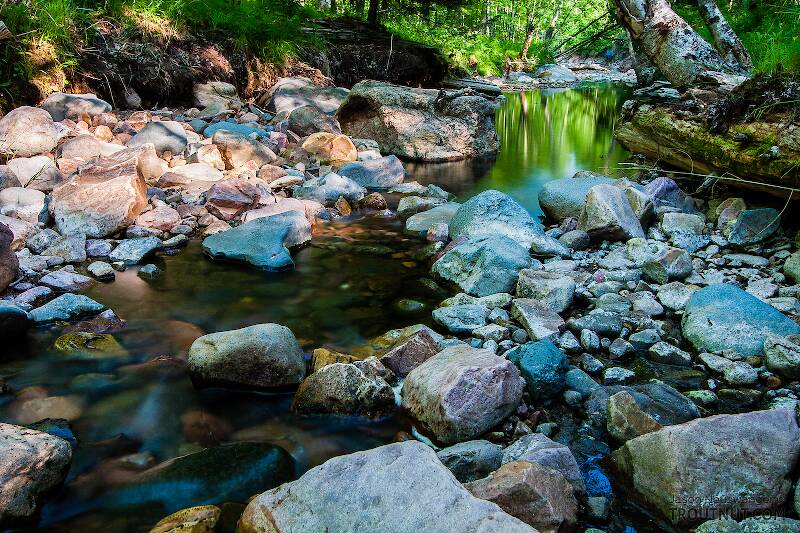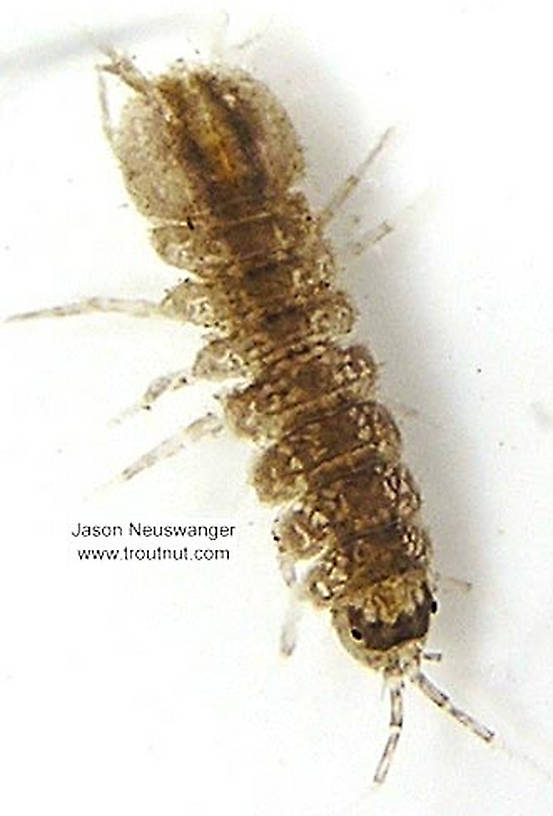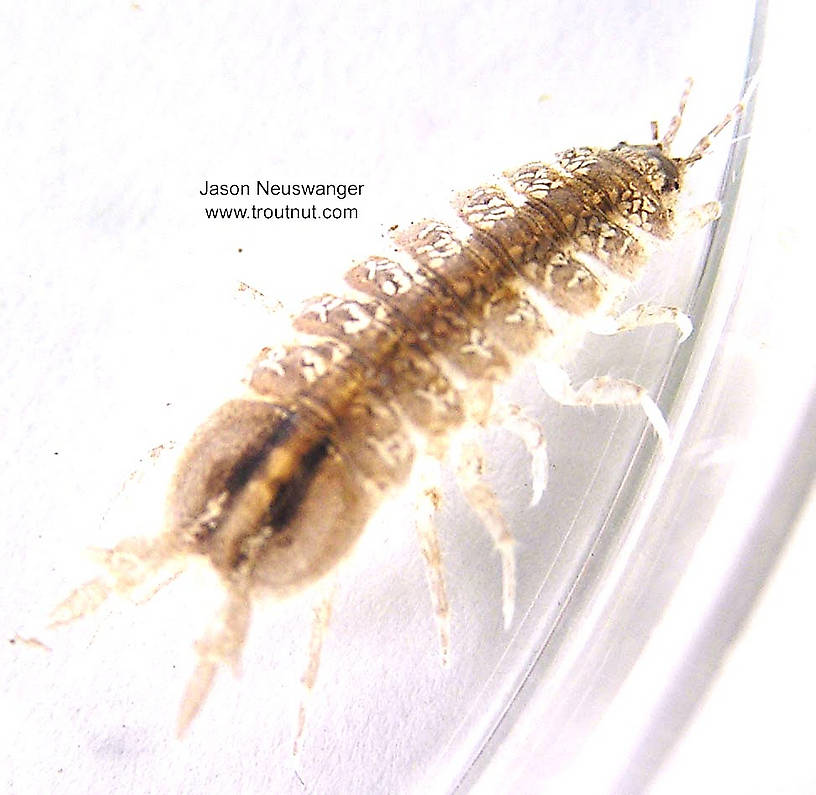
Salmonflies
Pteronarcys californica
The giant Salmonflies of the Western mountains are legendary for their proclivity to elicit consistent dry-fly action and ferocious strikes.
Featured on the forum

This species was fairly abundant in a February sample of the upper Yakima.

Troutnut is a project started in 2003 by salmonid ecologist Jason "Troutnut" Neuswanger to help anglers and
fly tyers unabashedly embrace the entomological side of the sport. Learn more about Troutnut or
support the project for an enhanced experience here.
This topic is about the Arthropod Family Asellidae
Cress Bugs are a common invertabrate in PA spring creeks. They are significant food forms for trout where found in abundance.Example specimens
Leonardo on Mar 28, 2013March 28th, 2013, 9:22 pm EDT
My name is Leonardo García, I am a biologist intern in the National Autonomous University of Mexico and I'm doing my thesis with title "Morphological variation in the genus Caecidotea isopods (Packard, 1871) (Crustacea: Peracarida: Isopoda) of Mexico." Inside the National Collection of Crustacean, Biology Institute (UNAM).
I was wondering if somebody can help me to get some specimens of the specie Caecidotea communis and send them to me to continue with my thesis work. It would help and enrich my study.
Thanks for your attention
Leo
I was wondering if somebody can help me to get some specimens of the specie Caecidotea communis and send them to me to continue with my thesis work. It would help and enrich my study.
Thanks for your attention
Leo
Taxon on Mar 29, 2013March 29th, 2013, 1:25 am EDT
Hi Leo-
I assume you are pursuing an advanced degree in marine biology, as I believe Caecidotea communis to be a marine isopod. As far as I know, folks on this forum would be more likely to be familiar with freshwater isopods.
Maybe I'm missing something here, but wouldn't it have been prudent to made sure you had an adequate source of the critters you were intending to study before embarking on the study? :-)
I assume you are pursuing an advanced degree in marine biology, as I believe Caecidotea communis to be a marine isopod. As far as I know, folks on this forum would be more likely to be familiar with freshwater isopods.
Maybe I'm missing something here, but wouldn't it have been prudent to made sure you had an adequate source of the critters you were intending to study before embarking on the study? :-)
Crepuscular on Mar 29, 2013March 29th, 2013, 3:32 am EDT
Rodger, Caecidotea communis is a freshwater isopod. We have it here in PA. Or maybe I'm missing something here...;)
Taxon on Mar 29, 2013March 29th, 2013, 6:51 am EDT
Hi Eric,
Ah, I stand corrected. Thanks for pointing out the error regarding my belief. :-)
Ah, I stand corrected. Thanks for pointing out the error regarding my belief. :-)
Troutnut on Mar 29, 2013March 29th, 2013, 10:06 am EDT
Leo said I had some of them on my site and asked if I could get him any more from Wisconsin, but since I'm in Alaska I pointed him here to see if anyone else could help.
Leo, if there are photos of that species on this site, can you post a link to their specimen pages so people can see what they're looking for? A description of the identifying characteristics of that species would be helpful, too.
Leo, if there are photos of that species on this site, can you post a link to their specimen pages so people can see what they're looking for? A description of the identifying characteristics of that species would be helpful, too.
Jason Neuswanger, Ph.D.
Troutnut and salmonid ecologist
Troutnut and salmonid ecologist
Entoman on Mar 29, 2013March 29th, 2013, 10:22 am EDT
Eric -
This one had me going as well. I've only seen the family name Asellidae when these critters are mentioned in FF literature. I've never run into them in my angling. Is Caecidotea communis the species name of your most common Cress Bug? Do they fill the niche in your SC weedbeds that Gammarus scuds do out here? Are they as photophobic? The only things I know are that they can be abundant in PA, are scavengers, and that they are worth imitating as the fish seem to relish them. Our hatch page on this critter is blank and I'd like to add any info you can provide.
Thanks,
This one had me going as well. I've only seen the family name Asellidae when these critters are mentioned in FF literature. I've never run into them in my angling. Is Caecidotea communis the species name of your most common Cress Bug? Do they fill the niche in your SC weedbeds that Gammarus scuds do out here? Are they as photophobic? The only things I know are that they can be abundant in PA, are scavengers, and that they are worth imitating as the fish seem to relish them. Our hatch page on this critter is blank and I'd like to add any info you can provide.
Thanks,
"It's not that I find fishing so important, it's just that I find all other endeavors of Man equally unimportant... And not nearly as much fun!" Robert Traver, Anatomy of a Fisherman
Entoman on Mar 29, 2013March 29th, 2013, 10:37 am EDT
Ah, we were thinking the same thing, Jason. I moved the topic to the hatch page. My hunch is the PA contingent will be able to help Leo.:)
"It's not that I find fishing so important, it's just that I find all other endeavors of Man equally unimportant... And not nearly as much fun!" Robert Traver, Anatomy of a Fisherman
Crepuscular on Mar 29, 2013March 29th, 2013, 11:34 am EDT
Honestly I don't have a species key so I can't tell you if what we have is communis. If it is. How many pounds do you want Leo? ;)
Entoman on Mar 29, 2013March 29th, 2013, 11:38 am EDT
:)LOL
"It's not that I find fishing so important, it's just that I find all other endeavors of Man equally unimportant... And not nearly as much fun!" Robert Traver, Anatomy of a Fisherman
Leonardo on Mar 29, 2013March 29th, 2013, 12:22 pm EDT
Thanks for the welcome! =)
Leonardo on Mar 29, 2013March 29th, 2013, 12:50 pm EDT
Hi all!
I'll be happy to provide taxonomic information as well as the biology of the freshwater isopod.
I have some identification keys that are very basic to clearly distinguish them with the help of a pair of microscopes.
I attached a link where you can see the key to Williams (1970) A revision of North American epigean species of Asellus. On pages 4-17 is the description of the species Caecidotea communis (most common in North America). I recommend paying attention to pages 8 and 11 as the palm of the second pleopod gnatopod are heavier characters in taxonomic identification.
This is the link to download the key
http://si-pddr.si.edu/jspui/bitstream/10088/5397/2/SCtZ-0049-Lo_res.pdf
To differentiate between males and females is easy. Pay attention to the palms of the gnatopod, it´s presence is a sexual dimorphism in males. Because this gnatopod is much larger in males (Figure A on page 8, first pereiopod).
Crepuscular, it would very kind of you could help me. I just need at least 20 specimens. Would it be possible to send me these specimens?
Thank you all!
I'll be happy to provide taxonomic information as well as the biology of the freshwater isopod.
I have some identification keys that are very basic to clearly distinguish them with the help of a pair of microscopes.
I attached a link where you can see the key to Williams (1970) A revision of North American epigean species of Asellus. On pages 4-17 is the description of the species Caecidotea communis (most common in North America). I recommend paying attention to pages 8 and 11 as the palm of the second pleopod gnatopod are heavier characters in taxonomic identification.
This is the link to download the key
http://si-pddr.si.edu/jspui/bitstream/10088/5397/2/SCtZ-0049-Lo_res.pdf
To differentiate between males and females is easy. Pay attention to the palms of the gnatopod, it´s presence is a sexual dimorphism in males. Because this gnatopod is much larger in males (Figure A on page 8, first pereiopod).
Crepuscular, it would very kind of you could help me. I just need at least 20 specimens. Would it be possible to send me these specimens?
Thank you all!
Quick Reply
Related Discussions
Topic
Replies
Last Reply
14
Dec 18, 2011
by PaulRoberts
by PaulRoberts
0
May 15, 2016
by Leonardo
by Leonardo
Re: I need your help to get some specimens of Caecidotea (Freshwater isopods).
In General Discussion by Leonardo
In General Discussion by Leonardo
4
Jun 1, 2016
by Crepuscular
by Crepuscular
12
Apr 15, 2015
by MiltRPowell
by MiltRPowell
3
Dec 10, 2015
by PaulRoberts
by PaulRoberts








